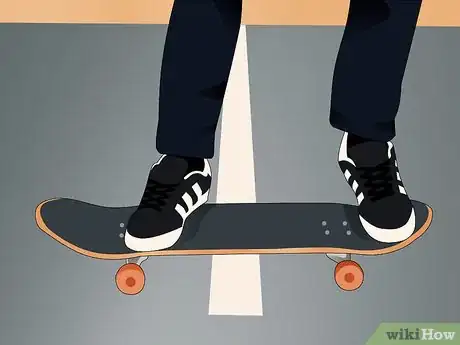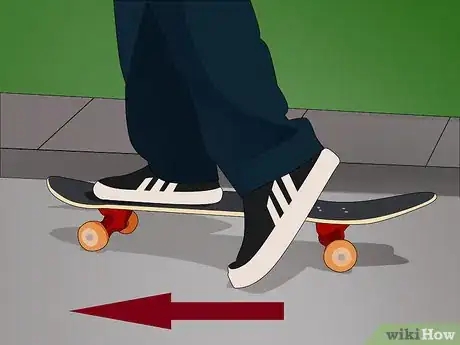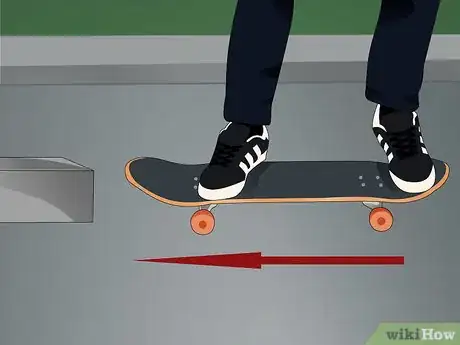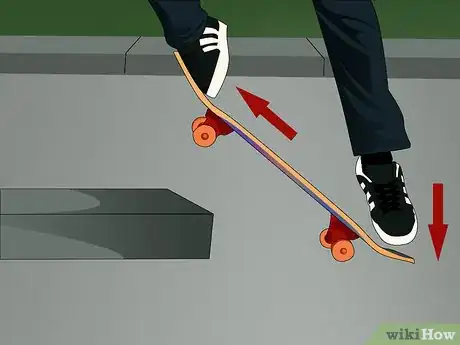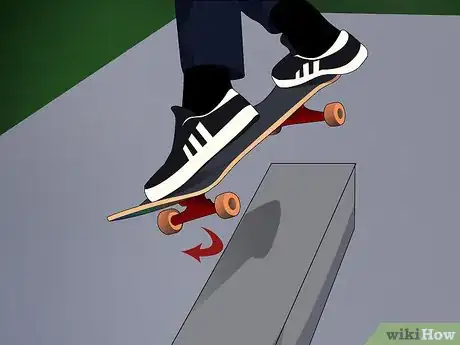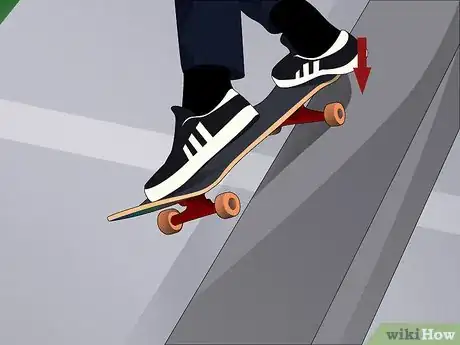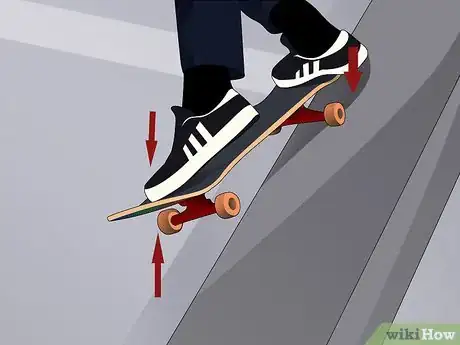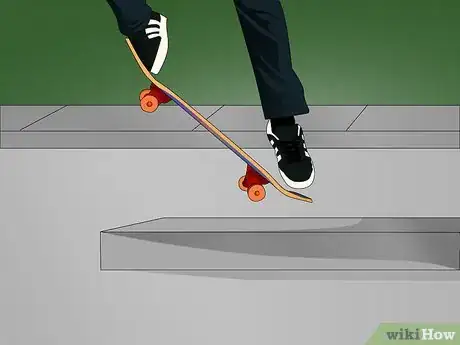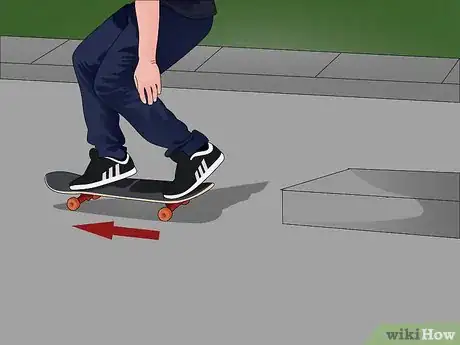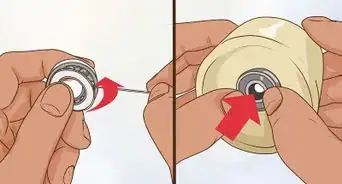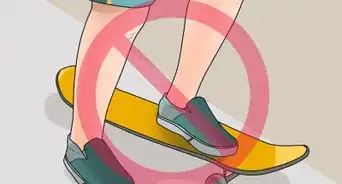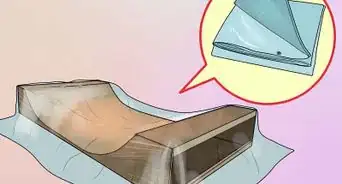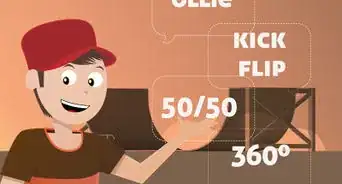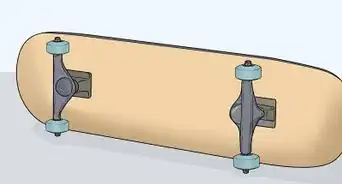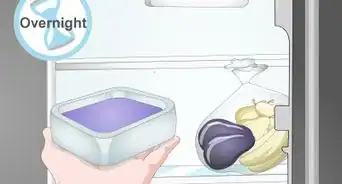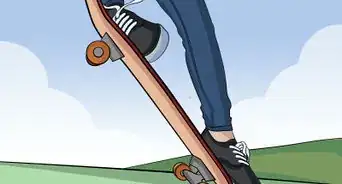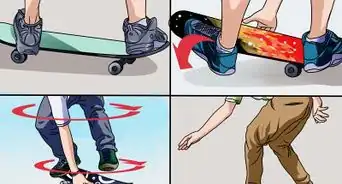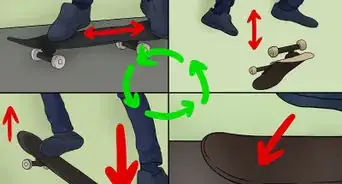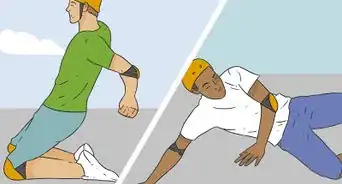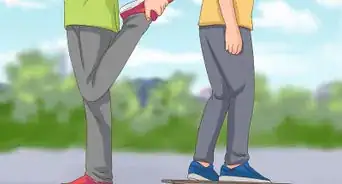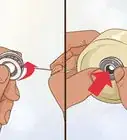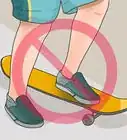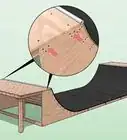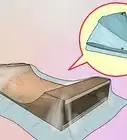This article was co-authored by wikiHow Staff. Our trained team of editors and researchers validate articles for accuracy and comprehensiveness. wikiHow's Content Management Team carefully monitors the work from our editorial staff to ensure that each article is backed by trusted research and meets our high quality standards.
There are 7 references cited in this article, which can be found at the bottom of the page.
This article has been viewed 27,816 times.
Learn more...
A Smith grind is a trick where you grind on only your back trucks. The nose of your board leans to one side of the rail or ledge. The Smith grind can be done on any rail, ledge, or curb. It involves you ollieing up onto a rail or ledge, locking your back trucks into a grind, and then popping off and landing back on the ground. This is an advanced trick. Before attempting a Smith grind, be comfortable with basic tricks like the ollie. You should also be comfortable with both 50/50 and 5-0 grinds before trying to Smith grind.
Steps
Setting up for Your Grind
-
1Position yourself properly on the board. To get up on the rail or ledge for a Smith grind you will need to position your body to perform an ollie.
- There are two types of Smith grinds: backside and frontside. However, the trick is always performed by grinding with only the back trucks on the rail or ledge. The difference between a backside and frontside is determined by which way you are facing when you grind on the rail. If you are facing the rail, that is a frontside Smith grind. If your back is to the rail, that is a backside.
- This is a complicated trick and before attempting to do a Smith grind, you should be comfortable doing a 50/50 and 5-0 grind. The 50/50 grind is a basic grind that places both trucks on the rail. The 5-0 grind places one set of trucks on the rail, causing you to balance the other end of the board above it.
- It’s best to learn this trick on a flat bar or ledge. A rounded bar will be harder to balance on.
-
2Shift your weight toward your back foot. As you push off and start rolling you will have to shift your weight toward your back foot as you prepare to ollie.
- Try pressing on the board with just the ball of your front foot to keep the nose of the board down as you start moving.
- You want both of your feet covering most of the width of your board. Meaning, you don’t want to have either foot hanging off the edge of your board much.
Advertisement -
3Skate toward the rail or ledge gaining some momentum. Come at the object at a moderate speed. [1]
- You’re going to need a bit of speed to ollie up onto the rail and grind the length of it. The speed you need will vary depending on the rail. If you go too slow you can get tripped up. Too fast and the board may slide out from under you. Finding a balance will take practice.
- Approach the rail or ledge so you’re almost parallel to it. You want to be at a slight angle, but if you’re angled too far your back trucks won’t land on the rail. Try approaching at roughly a forty-five-degree angle.
- Spot your point of entry. Look at the spot on the rail you wish to land. This will help your body work to get there and keep you balanced. Don’t look down at your board. If you do, you won’t be able to see where you’re headed and can miss the rail and injure yourself.
-
4Perform an ollie to get your board over the rail or ledge. Release your compression and pop the tail of your board down while sliding your front foot forward to ollie. [2]
- The speed you have will help you as will keeping your eye on your landing spot.
- If you’re new to this, practice on lower rails. You need to be able to ollie high enough so that your trucks are above the rail.
-
5Position your board for the Smith grind. The Smith grind is similar to a 50/50 in that you want to land with your trucks on the rail. But unlike a 50/50 with both trucks hitting the rail, here just your back ones will land.[3]
- Entering at a slight angle will help you to position and turn your board while in the air so that you only get your back trucks on the rail.
- Try coming in at about a forty-five-degree angle or a little less.
- Push the board forward a little with your feet to get close to the rail.
Landing and Grinding on the Rail
-
1Land on the rail. Push the front part of your board down so it is tilted towards the ground at an angle from the curb. [4]
- Once you land with your back trucks on the rail you want to push the tip of the board down so that the front trucks go to one side of the rail; unlike in a 50/50 when the front trucks land on the rail.
- Position your back foot in the pocket of your tail where the tail begins to slope up. You want to hold your foot over your trucks or slightly behind to provide a counterbalance so the tail of the board doesn’t pop down.
- Position your front foot so that you point your toes forward toward the front of the board. Or put pressure the ball of your foot.
- You want your front foot on the part of the board over the front trucks. It should be at an angle comfortable to you so that you can direct the front of your board over the rail.
-
2Lock your trucks in. As your back trucks are about to make contact with the rail or ledge, you want to kick your back foot in the direction of the rail. Think of it like stomping your trucks down to land on the rail and lock in. [5]
- Once the trucks are locked in, you want to apply a lot of weight to your back foot. This weight will hold the trucks in Smith grind position.
- Additionally, by putting most of your weight on the back of your board, you have more freedom of motion to get the front of your board down and to either side of the rail.
-
3Point the nose of your board down. Use your front toes or the ball of your foot to guide your nose down and away from the rail or ledge.
- When grinding on a rail, you can lock your back trucks in and lean the front of your board over as far as your balance will allow.
- When grinding on a ledge, you have to be careful to lock your back trucks in the center and find a more precise balance. You need to place a lot of balance on your back foot. Because you only have so much room on one side of the ledge, if you lean too far, your wheel will catch the ledge and you may roll off.
-
4Grind it out with almost all your weight on your back foot. Leaning back with the majority of your weight is what will propel your forward. Your front leg and foot are used as a counterweight and to direct the direction of your board’s front end.
- If you put too much weight on your front foot, you will end up dipping the nose of your board down too far. Dipping the nose too far can cause your board to slide off the rail or ledge.
- When on a ledge as opposed to a rail, keep the weight on your back foot but don’t put as much pressure on the part of your foot closest to the ledge. Too much pressure will cause you to slow because the wheel will be hitting the coping.
- For example, if you ride goofy (right foot in front) and do a frontside Smith grind on a ledge, you want to lean back a bit with less pressure on your toes. For regular skaters (left foot in front) doing a backside, it’s the opposite, with less pressure on your heel.
Coming off the Grind and Landing
-
1Ollie out of the Smith grind. You can sometimes choose to ride off the end of the rail or ledge if it’s short enough, but try to get used to ollieing out of your grind. [6]
- Treat the top of the rail or ledge as you would the ground and snap the tail of your board down onto it. While doing this motion, flick your front foot up and forward to bring the nose up and clear the rail or ledge.
- On some rails and ledges you can ride off the edge instead of ollieing out. But this works better on shorter grinds. When riding off the edge, put more pressure on the tail of your board to lift the nose up as you exit.
-
2Keep the board level as you go to land. Whether you ollie out of your grind or ride off the edge, shift your weight to your body’s center to help you level out your board for a smooth landing.
- If you are leaning too far back you risk landing on just your back wheels. Landing this way is fine if you are skilled enough to manual, but you risk the board shooting out from under your feet.
- If you’re too forward you won’t be able to pull the nose up enough and could exit the grind with the nose of your board hitting the ground.
-
3Stick the landing and ride away. Once you hit the pavement your body may be a little unbalanced. It will take time to get used to quickly adjusting and connecting all four wheels to the ground to ride away.
- Bend your knees to absorb the shock of landing. Bending will also help you to center your balance and stay on your board. [7]
- Use your arms to further help you balance and center your weight.
-
4Practice Smith grinds on all types of rails and ledges. Different surfaces will help you to get used to grinding and exiting off the rail or ledge.
- Flat rails are the best to learn to do this trick on. The flat rail allows you plenty of surface area to lock your trucks into and doesn’t restrict you to one side.
- Ledges are a bit harder as you have to have really precise balance and make sure you get the nose of your board far enough to one side.
- Rounded rails can be tricky because the surface isn’t flat. If you don’t have exceptional balance you can easily roll too far to one side of the rail and fall. It’s very hard so don’t give up.
Warnings
- Always wear proper protective gear. You should be wearing a helmet, arm and leg pads, and even wrist guards.⧼thumbs_response⧽
- The Smith grind is an advanced trick. You should be comfortable with more basic tricks and grinds before attempting this trick.⧼thumbs_response⧽
References
- ↑ https://www.youtube.com/watch?v=CEIJdkCVfCg
- ↑ https://www.youtube.com/watch?v=nCrhf-pyX_g
- ↑ https://sidewalkmag.com/skateboard-tricks/advanced-tricks/fs-smith-grind-sidewalk-basics.html#UGWo0kWQ3tgPXMbI.97
- ↑ http://skateboarding.transworld.net/videos/how-to-backside-smith-grind-with-frankie-spears/#WCfWRcE8vPDZi5h6.97
- ↑ https://www.youtube.com/watch?v=C-Z48xJKExA
- ↑ https://sidewalkmag.com/skateboard-tricks/advanced-tricks/fs-smith-grind-sidewalk-basics.html/2#SVwA3dE5osrLKmSM.97
- ↑ https://sidewalkmag.com/skateboard-tricks/advanced-tricks/fs-smith-grind-sidewalk-basics.html/3#K3PFbLt87a5I3Gfp.97
